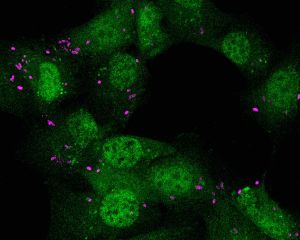
Imagen: Cultivo de fibroblastos expresando un regulador de respuesta inflamatoria (en verde) infectados con Salmonella (en magenta)/ F. García del Portillo, CNB-CSIC.
Los resultados, publicados en PLoS Pathogens, han sido factibles gracias a la aplicación de nuevas metodologías de cromatografía líquida ultra-sensible y espectrometría de masas que permiten la obtención de gran información a partir de cantidades muy reducidas de material. “Por primera vez, y tras el análisis estructural del peptidoglicano de Salmonella cuando se localiza en un compartimento intracelular, hemos comprobado que dicho ambiente estimula cambios no detectados con anterioridad en otras localizaciones” destaca Francisco García del Portillo, investigador del CSIC en el Centro Nacional de Biotecnología (CNB-CSIC). Algunas modificaciones en la estructura de este peptidoglicano, como un cambio del aminoácido D-alanina, por alaninol (un amino alcohol) en alrededor de un 2% de las cadenas laterales del peptidoglicano, reducen la activación de la respuesta pro-inflamatoria. La confirmación de actividad anti-inflamatoria en péptidos con este amino alcohol obtenidos por síntesis química pone de relieve la transcendencia de este nuevo hallazgo.
Para Sónia Castanheira, investigadora en el CNB-CSIC, el reto futuro es “obtener suficiente material intracelular bacteriano desde su compartimento intracelular para poder realizar ensayos in vitro y conocer con exactitud las estructuras del peptidoglicano que interfieren con la respuesta inmune en la célula infectada”. “Dado que detectamos el alaninol en la estructura que cubre la bacteria intracelular, es esperable que la constante actividad de “rotura y cierre” de enlaces del peptidoglicano asociada al crecimiento de la célula pudiera culminar en la liberación de fragmentos conteniendo este inusual amino alcohol”.
Este estudio abre nuevas vías de erradicación selectiva de la infección intracelular, proponiendo la inhibición de la formación de alaninol como una novedosa vía de actuación sobre las infecciones causadas por Salmonella.
El metabolismo del peptidoglicano ofrece nuevas dianas en terapia antimicrobiana
La pared celular es una cubierta externa que al tener el peptidoglicano como componente principal, protege a las bacterias frente a cambios ambientales y de presión, asegurando su integridad celular y definiendo su forma. La síntesis del peptidoglicano ha sido históricamente elegida como proceso esencial sobre el que desarrollar medicamentos antibacterianos, siendo ejemplos antibióticos como vancomicina, cicloserina, fosfomicina o los beta-lactámicos. No obstante, al ser el metabolismo básico del peptidoglicano común en bacterias patógenas y aquellas que componen nuestra microbiota beneficiosa, el interés actual se dirige a actividades relacionadas con su metabolismo que sean exclusivas del organismo infeccioso evitando así daños colaterales no deseados. La definición de cambios estructurales del peptidoglicano no observados en el ambiente extracelular abre otro nivel de actuación dirigido selectivamente al control de las infecciones intracelulares, siempre difíciles de erradicar.
Más información
SB Hernández, S Castanheira, MG Pucciarelli, JJ Cestero, G Rico-Pérez, A Paradela, JA Ayala, S Velázquez, A San-Felix, F Cava, F García-del Portillo. Peptidoglycan editing in non-proliferating intracellular Salmonella as source of interference with immune signaling. Plos Pathogens 2022; 18(1):e110241; DOI: http://doi.org/10.1371/journal.ppat.1010241
CNB-CSIC Comunicaicón






